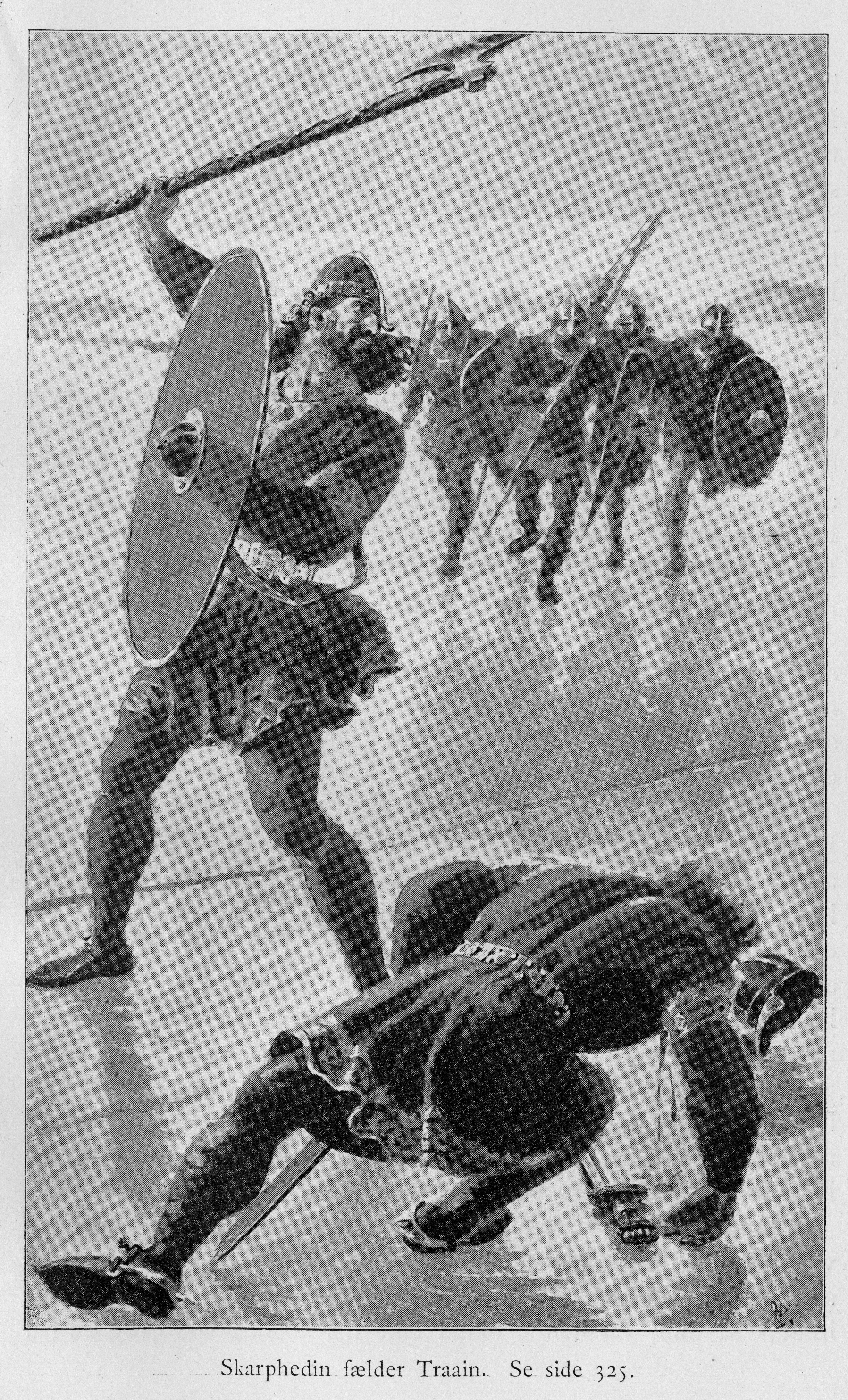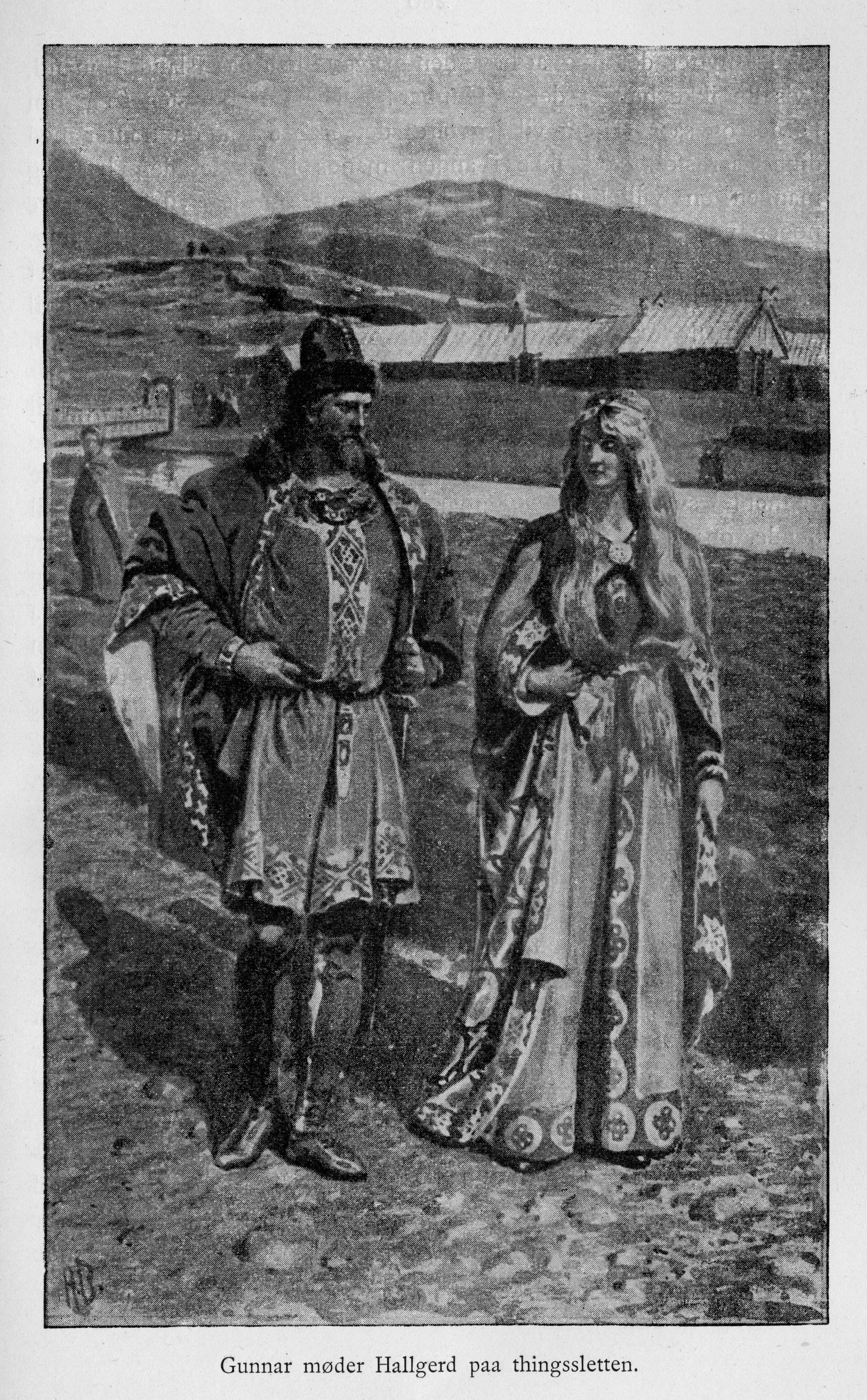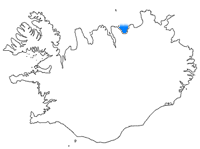|
Garðar Svavarsson
Garðarr Svavarsson (Old Norse: ; Modern Icelandic: ; Modern Swedish: ) was a Swede who briefly resided in Iceland, according to the Sagas. He is said to be the second Scandinavian to reach the island of Iceland after Naddod. He and his family appear in the Icelandic Sagas with the principal source from Haukr Erlendsson's edition of Landnámabók. Biography Svavarsson is described as a Swedish Viking who owned land in Zealand (in modern Denmark). He was married to a woman from the Hebrides. During the 860s, he needed to claim his inheritance from his father-in-law. During a voyage to these isles, he sailed into a storm at Pentland Firth. This storm pushed his ship far to the north until he reached the eastern coast of Iceland. He circumnavigated the island, becoming the first known person to do so and thus establishing that the landmass was an island. He went ashore at Skjálfandi where he built himself a house and stayed for the winter. Since then, the place located in North ... [...More Info...] [...Related Items...] OR: [Wikipedia] [Google] [Baidu] |
Old Norse
Old Norse, Old Nordic, or Old Scandinavian, is a stage of development of North Germanic languages, North Germanic dialects before their final divergence into separate Nordic languages. Old Norse was spoken by inhabitants of Scandinavia and their Viking expansion, overseas settlements and chronologically coincides with the Viking Age, the Christianization of Scandinavia and the consolidation of Scandinavian kingdoms from about the 7th to the 15th centuries. The Proto-Norse language developed into Old Norse by the 8th century, and Old Norse began to develop into the modern North Germanic languages in the mid-to-late 14th century, ending the language phase known as Old Norse. These dates, however, are not absolute, since written Old Norse is found well into the 15th century. Old Norse was divided into three dialects: Old West Norse, ''Old West Norse'' or ''Old West Nordic'' (often referred to as ''Old Norse''), Old East Norse, ''Old East Norse'' or ''Old East Nordic'', and ''Ol ... [...More Info...] [...Related Items...] OR: [Wikipedia] [Google] [Baidu] |
Húsavík
Húsavík () is a town in Norðurþing municipality on the north coast of Iceland on the shores of Skjálfandi bay with 2,307 inhabitants. The most famous landmark of the town is the wooden church Húsavíkurkirkja, built in 1907. Húsavík is served by Húsavík Airport. Overview Income is derived from tourism and fishing, as well as retail and small industry. Until recently, Húsavík was the export harbour for silica that was extracted from nearby lake Mývatn. According to the ''Landnámabók'' ("Book of Settlement"), Húsavík was the first place in Iceland to be settled by a Norseman. The Swedish Viking Garðar Svavarsson stayed there for one winter around 870 A.D. When he left the island in spring of 870, after a winter's stay, he left behind a man named Náttfari and two slaves, a man and a woman, and they established a farm here. The name of the town means "bay of houses", probably referring to Garðar's homestead, which may have been the only houses then in Iceland. ... [...More Info...] [...Related Items...] OR: [Wikipedia] [Google] [Baidu] |
9th-century Icelandic People
The 9th century was a period from 801 ( DCCCI) through 900 ( CM) in accordance with the Julian calendar. The Carolingian Renaissance and the Viking raids occurred within this period. In the Middle East, the House of Wisdom was founded in Abbasid Baghdad, attracting many scholars to the city. The field of algebra was founded by the Muslim polymath al-Khwarizmi. The most famous Islamic Scholar Ahmad ibn Hanbal was tortured and imprisoned by Abbasid official Ahmad ibn Abi Du'ad during the reign of Abbasid caliph al-Mu'tasim and caliph al-Wathiq. In Southeast Asia, the height of the Mataram Kingdom happened in this century, while Burma would see the establishment of the major kingdom of Pagan. Tang China started the century with the effective rule under Emperor Xianzong and ended the century with the Huang Chao rebellions. While the Maya experienced widespread political collapse in the central Maya region, resulting in internecine warfare, the abandonment of cities, and a northward ... [...More Info...] [...Related Items...] OR: [Wikipedia] [Google] [Baidu] |
Viking Explorers
Vikings ; non, víkingr is the modern name given to seafaring people originally from Scandinavia (present-day Denmark, Norway and Sweden), who from the late 8th to the late 11th centuries raided, pirated, traded and settled throughout parts of Europe.Roesdahl, pp. 9–22. They also voyaged as far as the Mediterranean Sea, Mediterranean, North Africa, Volga Bulgaria, the Middle East, and Greenland, North America. In some of the countries they raided and settled in, this period is popularly known as the Viking Age, and the term "Viking" also commonly includes the inhabitants of the Scandinavian homelands as a collective whole. The Vikings had a profound impact on the Early Middle Ages, early medieval history of Scandinavia, the History of the British Isles, British Isles, France in the Middle Ages, France, Viking Age in Estonia, Estonia, and Kievan Rus'. Expert sailors and navigators aboard their characteristic longships, Vikings established Norse settlem ... [...More Info...] [...Related Items...] OR: [Wikipedia] [Google] [Baidu] |
Swedish Explorers
Swedish or ' may refer to: Anything from or related to Sweden, a country in Northern Europe. Or, specifically: * Swedish language, a North Germanic language spoken primarily in Sweden and Finland ** Swedish alphabet, the official alphabet used by the Swedish language * Swedish people or Swedes, persons with a Swedish ancestral or ethnic identity ** A national or citizen of Sweden, see demographics of Sweden ** Culture of Sweden * Swedish cuisine See also * * Swedish Church (other) * Swedish Institute (other) * Swedish invasion (other) * Swedish Open (other) Swedish Open is a tennis tournament. Swedish Open may also refer to: *Swedish Open (badminton) * Swedish Open (table tennis) *Swedish Open (squash) *Swedish Open (darts) The Swedish Open is a darts tournament established in 1969, held in Malm� ... {{disambig Language and nationality disambiguation pages ... [...More Info...] [...Related Items...] OR: [Wikipedia] [Google] [Baidu] |
Náttfari
Náttfari (Old Norse: ; Modern Icelandic: ; c.835) was a crew member who escaped his master, Garðar Svavarsson, and may have become the first permanent resident of Iceland in the 9th century. The earliest account of his story is found in the 11th century Icelandic Book of Settlements (''Landnámabók''). Náttfari escaped when Garðar set sail to the Hebrides from the newfound island which he named Garðarshólmi, now known as Iceland. When Garðar Svavarsson left Iceland after a winter's stay in the spring of 870, moving east towards Norway, a boat drifted away. On the boat were Náttfari with a slave (''thræll'') and a bond woman (''ambátt''). Garðar reached the shores of Iceland on the north coast. Náttfari found a place for them to live now known as Náttfaravík, a cove on Skjálfandi Bay which is situated directly opposite to the town of Húsavík Húsavík () is a town in Norðurþing municipality on the north coast of Iceland on the shores of Skjálfandi bay ... [...More Info...] [...Related Items...] OR: [Wikipedia] [Google] [Baidu] |
Njáls Saga
''Njáls saga'' ( ), also ''Njála'' ( ), ''Brennu-Njáls saga'' ( ) or ''"The Story of Burnt Njáll"'', is a thirteenth-century sagas of Icelanders, Icelandic saga that describes events between 960 and 1020. The saga deals with a process of blood feuds in the Icelandic Commonwealth, showing how the requirements of honor could lead to minor slights spiralling into destructive and prolonged bloodshed. Insults where a character's manhood is called into question are especially prominent and may reflect an author critical of an overly restrictive ideal of masculinity. Another characteristic of the narrative is the presence of omens and prophetic dreams. It is disputed whether this reflects a fatalism, fatalistic outlook on the part of the author. The principal characters in the saga are the friends Njáll Þorgeirsson, a lawyer and a sage, and Gunnar Hámundarson, a formidable warrior. Gunnar's wife, Hallgerðr langbrók, instigates a feud that leads to the death of many character ... [...More Info...] [...Related Items...] OR: [Wikipedia] [Google] [Baidu] |
Gunnar Hámundarson
Gunnar Hámundarson () was a 10th-century Icelandic chieftain. He lived in Hlíðarendi in Fljótshlíð and is probably better known as Gunnar of Hlíðarendi ( non, Gunnarr á Hlíðarenda). He features prominently in the first half of Njáls saga, which tells of the chain of events ultimately leading to his death in battle. He was married to Hallgerðr Höskuldsdóttir of Höskuldsstaðir in Laxárdal in Dalasýsla, who was known as Hallgerðr langbrók ("Hallgerður longpants"). He was her third husband. It was said that she had killed both her former husbands, but she had in fact only killed the first. Their marriage was considered imprudent by Gunnar's friend Njáll Þorgeirsson, because it was caused by lust and not practicality. Gunnar the hero Gunnar was a god-like warrior — he is described as nearly invincible in combat. According to Njáls saga, he was a powerful, athletic man "capable of jumping his own height in full body armour, both back and front". He ... [...More Info...] [...Related Items...] OR: [Wikipedia] [Google] [Baidu] |
Sagas Of Icelanders
The sagas of Icelanders ( is, Íslendingasögur, ), also known as family sagas, are one genre of Icelandic sagas. They are prose narratives mostly based on historical events that mostly took place in Iceland in the ninth, tenth, and early eleventh centuries, during the so-called Saga Age. They were written in Old Icelandic, a western dialect of Old Norse. They are the best-known specimens of Icelandic literature. They are focused on history, especially genealogical and family history. They reflect the struggle and conflict that arose within the societies of the early generations of Icelandic settlers. The Icelandic sagas are valuable and unique historical sources about medieval Scandinavian societies and kingdoms, in particular in regards to pre-Christian religion and culture. Eventually many of these Icelandic sagas were recorded, mostly in the 13th and 14th centuries. The 'authors', or rather recorders of these sagas are largely unknown. One saga, ''Egil's Saga'', is beli ... [...More Info...] [...Related Items...] OR: [Wikipedia] [Google] [Baidu] |
Names Of Iceland
There are numerous different names for Iceland, which have over the years appeared in poetry or literature. In Icelandic Many names have been used to refer to Iceland in the Icelandic language. These names include colloquial, formal, and poetic forms: * Eylenda , ''fem.''—island, that is to say Iceland *: Stephan G. Stephansson *:: ''Fjarst í eilífðar útsæ'' *:: ''vakir eylendan þín. *::: Far in the eternal yonder sea *::: your island wakes. * Fjalladrottning , ''fem.''—queen of the mountain or Iceland * Fjallkonan , ''fem.'' with definite article— lady of the mountain, a figure representing Iceland * Frón , ''neu.''— old Norse word for land, Iceland *: ''Heima á Fróni.'' * Garðarshólmi , ''masc.''—Iceland, named after Gardar Svavarsson * Hrímey , ''fem.'' * Hrímgrund , ''fem.'' * Hrímland , ''neu.''—(the book '' Crymogaea'' occasionally uses “Hrímland”) * Ísafold , ''neu.'' * Ísaland , ''neu.'' *: ''...og flykkjast heim að fögru landi Ís ... [...More Info...] [...Related Items...] OR: [Wikipedia] [Google] [Baidu] |
Icelandic Names
Icelandic names are names used by people from Iceland. Icelandic surnames are different from most other naming systems in the modern Western world by being patronymic or occasionally matronymic: they indicate the father (or mother) of the child and not the historic family lineage. Iceland shares a common cultural heritage with the Scandinavian countries of Denmark, the Faroe Islands, Norway, and Sweden. Unlike other Nordics, Icelanders have continued to use their traditional name system, which was formerly used by all Nordic countries except Finland, whose indigenous people are Uralic speakers and thus distinct from the Germanic rest of Scandinavia. The Icelandic system is thus not based on family names (although some people do have family names and might use both systems). Generally, with few exceptions, a person's last name indicates the first name of their father (patronymic) or in some cases mother (matronymic) in the genitive, followed by ("son") or ("daughter"). Some fam ... [...More Info...] [...Related Items...] OR: [Wikipedia] [Google] [Baidu] |
Skjálfandi
Skjálfandi (; also known as Skjálfandaflói ) is a bay in northern Iceland, with some of the characteristics of a fjord. The Icelandic word ''Skjálfandi'' literally translates to ''trembling'' which may refer to earthquakes in the area. The bay, originally created by glacial activity, has two major rivers flowing into it: Skjálfandafljót, which is a glacier river, and Laxá, which is a freshwater river. The river Laxá ("Salmon River") is famous for its salmon and part of the river is protected by the Ramsar Convention. The only town in Skjálfandi Bay is Húsavík, facing the snow-covered Víknafjöll and Kinnarfjöll mountain ranges on the other side of the bay. The highest point reaches around . The bay is known for its many different whale, dolphin and bird species. There are two islands in Skjálfandi. The larger one is Flatey (''flat island''). It is situated close to the opposite side of the bay from Húsavík. There is a village on the island, no longer ... [...More Info...] [...Related Items...] OR: [Wikipedia] [Google] [Baidu] |






